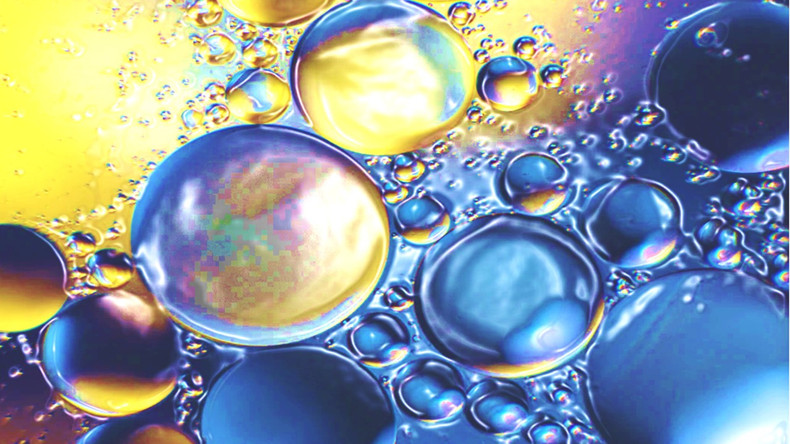Shampoo is a basic hair care product representing the largest segment of hair care cosmetics. Shampoo is typically in the form of a viscous liquid with some exception of waterless solid form such as a bar. Shampoo was developed to replace soap for cleansing scalp and hair by removing unwanted sebum, dandruff, environmental dust, and residues of hair care products. Most of the dirt including sebum are water insoluble and cannot be effectively removed by water alone. Therefore, a shampoo containing a combination of surfactants is necessary. The content of surfactants in a shampoo is typically between 10% and 20%.
From the Lab
Surfactants emulsify oily dirt on hair and scalp, then the dirt can be pulled into water and washed off easily. ( Fig. 1) The cleansing effect of a shampoo can be observed by comparing the scalp image under a microscope before and after using shampoo (Fig. 2) After shampooing, scalp becomes clean and free of the oily dirt until fresh sebum is regenerated. This action helps maintain personal hygiene and reduce the chance of scalp inflammation, itching, and odor.
Shampoo Types
Surfactants are placed in different classes for their uses as a primary cleansing agents in shampoo. Some are often used as cosurfactants in shampoo to stabilize them, helping improve lather and thicken properties.
In addition to shampoo's primary cleansing function, antidandruff shampoos and conditioning shampoos also became popular decades ago.
Dandruff is a common scalp disorder often accompanied by scalp itching. It is known that dandruff is associated with a scalp-specific fungus named Malassezia. This fungus on the scalp produce sebum resulting in an unsaturated lipid byproduct. The unsaturated lipid penetrates into top layer of the epidermis, resulting in an inflammatory reaction. Dandruff is considered a result of the inflammatory reaction.
Well-known antifungal shampoos usually have actives include zinc pyrithione, sulfur, salicylic acid, and coal tar that are found on the label. Among these, zinc pyrithione and sulfur are the most widely applied antidandruff actives.
Conditioning shampoos, sometimes called 2-in-1 shampoos, were introduced to global markets in the late 1980s. A conditioning shampoo is designed to deposit conditioning actives onto hair while washing off dirt at the same time. In order to make this happen, technology innovations were made in several areas: (1) stable dispersion of the water-insoluble conditioning actives such as silicones and conditioning oils; (2) efficient deposition of the conditioning actives onto hair; and (3) even distribution of the conditioning actives on hair surface. There is a laundry list of ingredients that helps this solubility process the most widely know is Polysorbate and Oleths.
Shampoo is generally used by applying it to wet hair, massaging the product into the hair, and then rinsing it out thoroughly. Most of the time, the conditioning effect expected from the shampoo is not enough because it is rinse away twice. While some people may follow the shampooing step with the use of hair conditioner, there are still people who may only use shampoo as daily hair shampooing and conditioning product.
Conditioners in Shampoos
Hair conditioning effects such as making hair smooth, soft, easy to comb, etc. are expected from a shampoo by these consumers at both wet hair and dry hair stages. Wet hair conditioning of shampoo is mainly delivered by a cationic polymer and surfactant in water. On the other hand, once hair is dry the conditioning is primarily the result of depositing silicones and conditioning oils on hair surface.
There is a unique type of electrostatically tango going on in the shampoo, resulting from positive and negative charged ions coming off of polymers and the surfactants in the water. They should continue to do this dance for at least 3 years and if they stop dancing you'll notice a separation between the two in the bottle.
Silicones and/or conditioning oils are usually formulated in a conditioning shampoo to provide smoothness, softness, and shine to dried hair. The hair surface lubrication effect is the basic reason for using these oils. When hair friction is reduced, there is less resistance to movement, frizz, so people may feel that hair is soft, smooth and easy to comb. Furthermore, having all the hair fall into place, allows better reflection of hair surface to light, giving shiner, healthier looking hair.
Silicones such as dimethicone, dimethiconol, and amodimethicone are the most widely applied oils for conditioning dry hair. A variety weights and viscosities make silicone unique among all of the conditioning oils. A comparison between silicone treated and untreated hair surfaces is shown on Fig. 3
Sulfate or Sulfate Free? Silicone or Silicone Free?
Moreover, recently sulfate-free and silicone-free shampoos are becoming popular in some markets. Consumers select sulfate-free shampoos for lower chance of skin and eye irritation or contact allergy normally cause by sulfate base shampoos. Some consumers also believe that silicone-free shampoo is a healthier or more environmentally friendly way to choose.
What most consumer don't know Sulfate-free shampoos and silicone-free shampoos may not be simply achieved by removing these ingredients from the shampoo, requiring new technology innovations. First, to be sulfate-free, low-irritation surfactants are needed to replace sulfate-based surfactants. Several classes of amino acid derivatives are often used for this purpose. These amino acid-based surfactants are reported to be milder than the traditional sulfate-based ones. However, other than higher in cost, these amino acid-based surfactants are often found less efficient in the lathering and giving off the functionality of a traditional shampoo. Consumers have even complained that the cleansing factor of the hair is sub par to traditional shampoos leaving them feeling as if the hair wasn't shampooed at all.
Market Trend
Pivotal Products was plagued with these same challenges to as our competitor. But we took the challenge head on, innovating a Sulfate free shampoo that carries all three of the primary amino acid surfactants to give that traditional feel of a sulfate shampoo with the gentleness of cleansing the hair to boot.
What's New and Hot.
Dry Shampoos
The science of dry shampoo is relatively simple, a powder or aerosol type spray applied to dry hair to absorb oil from the scalp. Dry shampoo doesn't need to be shampooed out. Dry shampoo uses alcohols or starch-based active ingredients to soak up the oils and sweat from your hair. Removing the oils from your hair makes it appear cleaner. Most dry shampoos also include a fragrance, which makes your hair smell fresh between washes.
This trend is hot for European hair types and is starting to catch on with African American women wearing lace front wigs and other additions to their natural hair. For natural curly to kinky type hair, it pose more of a challenge because of the tight coily nature of the hair. The application of a dry shampoo gives off the appearance and feel of something weighing the hair down oppose to the lite and airy free flowing feel. If you are using dry shampoos, we would love to hear your feedback.
Need Help?
1. If your experiencing scalp or skin irritation from a shampoo, Discontinue use and contact your physician or a dermatologist. Find a Dermatologist here.
2. To read more about skin diseases and disorders , American Academy of Dermatology (AAD)
3. Read more about Eczema here.

